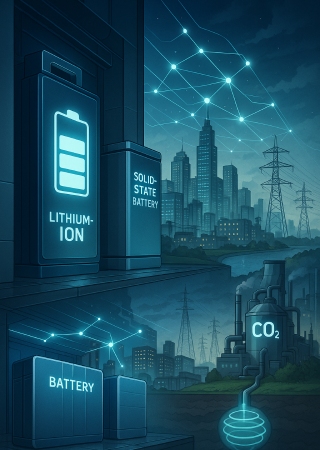Emerging Technologies in Energy

Emerging technologies herald the future energy systems, interfacing with challenges faced by renewable energy in its integration, storage, and emission reduction.
Battery Storage
Battery storage advancements are top-tier in solving renewable energy's big problem of intermittency. With the advent of lithium-ion and solid-state battery technologies, we witness ever-increasing efficiency in storage, so much so that renewable energy is utilized depending on the situation when demand is high and supply is low.
Smart Grids
Smart grids use digital technology to control the flow of electricity efficiently. This creates a better opportunity to integrate renewable sources, cutting down on wastage, and improving system reliability while letting consumers participate in monitoring their energy use.
Carbon Capture and Storage (CCS)
Carbon capture and storage (CCS) captures CO2 emissions from power plants and industrial processes and then stores the emissions underground. Though still emerging, CCS offers a great opportunity to significantly reduce emissions from existing fossil fuel plants as we transition toward renewable energy.
Renewable Energy Targets and Government Initiatives
The world is witnessing governments setting ambitious renewable energy targets to tackle climate change and still making countries strive away from fossil fuels. In many countries, there exist declarations to achieve net-zero emissions by half of the century, with renewable energy at the forefront. Therefore, to sustain the change, governments institute laws to support renewable energy projects through subsidy regimes, tax breaks, or simply grants. Allied with global agreements such as the Paris Agreement wherein clean energy solutions are encouraged at the national level, all these initiatives tend to promote renewable technologies, reduce the costs, and work toward achieving international climate targets setting the way for a sustainable energy scenario.
Potential Challenges
While the future of energy appears promising, existing several challenges must guarantee a smooth transition to a renewable system.
The Availability of Materials
Renewable energy depends upon some materials like lithium, cobalt, and rare-earth metals. These are just some limited resources whose extraction sometimes leads to environmental and social concerns. Hence, the sustainable management of supplies remains a key to potential growth.
Infrastructure Constraints
The infrastructure for renewable energy itself-the smart grid, and the storage system-needs substantial investment. Many countries face the challenge of finding that money, especially developing ones, while the old infrastructure awaits an upgrade to another technology.
The Policy and Regulatory Hurdles
So enactment of strong policies and regulatory framework must be guaranteed for broad-based development of renewable energy. However, the subsidies to fossil fuel, political barriers, and irregular regulations constitute impediments and retard the transition hereby also curbing global cooperation in the process.
A Brighter Tomorrow
The future lies in emerging technologies like Battery Storage, Smart Grids, and Carbon Capture, alongside ambitious renewable energy targets and government initiatives. Despite progress, challenges like resource limitations, infrastructure upgrades, and political delays remain. Addressing these issues through innovation, investment, and global collaboration will be key to building a sustainable, low-carbon energy future. With the right policies and technologies, the world can transition to a more resilient and beneficial energy system for both people and the planet.